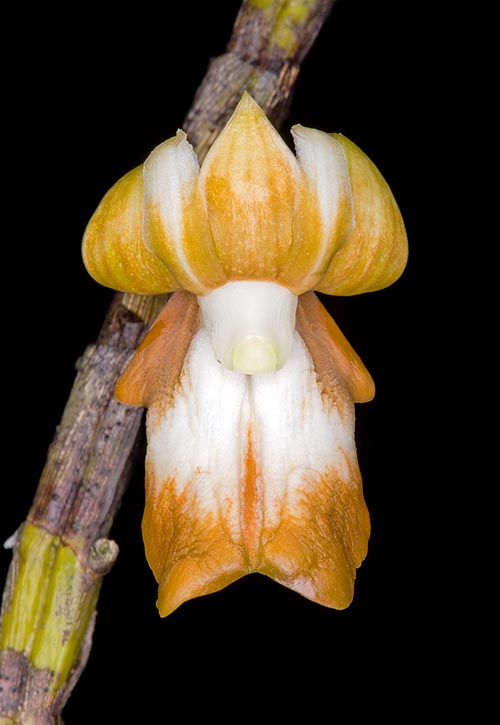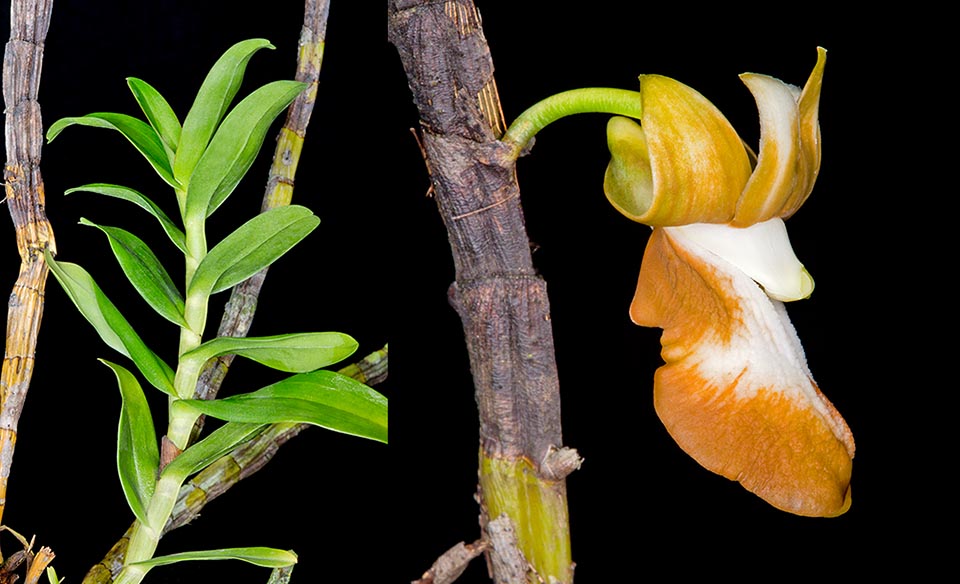Family : Orchidaceae

Text © Pietro Puccio

English translation by Mario Beltramini

Dendrobium kenepaiense is a Bornean epiphyte almost unknown in cultivation © Giuseppe Mazza
The name of the genus s the combination of the Greek substantives “δένδρον” (dendron) = tree and “βίος” (bios) = life, with reference to the numerous species of the genus living on the trees; the name of the species refers to place where it has been found, Kenepai.
The Dendrobium kenepaiense J.J.Sm. (1918) is an epiphytic species with cylindrical, 30-40 cm long pseudobulbs, provided of alternate leaves, distichous, ovate, with irregularly bilobed apex, coriaceous, 3-7,5 cm long and 1-1,8 cm broad.
Single flowers at the nodes, of 2-3,5 cm of diameter, of cream white colour with pale brown veins and hues. Ovate sepals with pointed apex, retroflexed, about 1,6 cm long and 0,8 cm broad, the lateral two being merged at the base of the column forming a sort of short conical spur (mentum), ovate petals with popinted apex, about 1,4 cm long and 0,4 cm broad, retroflexed, trilobed labellum, up to about 3 cm long and 2,8 cm broad, with retroflexed lateral lobes and ample median lobe with bilobed apex and retroflexed lateral margins.
It reproduces by seed, in vitro, and division, to be done at the vegetative restart, with each section provided of at least 3-4 pseudobulbs.
Species with small flowers of particular shape almost unknown in cultivation, requires high luminosity, medium-high temperatures in spring-summer, 24-32 °C, slightly cooler in winter, high humidity, 60-80%, and constant ventilation.
Regular and abundant waterings during the growth of the pseudobulbs, more spaced in winter until the vegetative restart, using rainwater, demineralised or by reverse osmosis.
For the fertilizations, which are to be suspended during the vegetative stasis, may be utilized hydrosoluble balanced products, with microelements, at ¼ of the dosage suggested on the package, duly alternated to the waterings in order to avoid salts accumulations in the compost. It can be mounted on branches, bark or cork rafts or cultivated in pot with particularly draining compost that can be formed by medium sliced bark fragments with addition of inerts for a better aeration of the roots.

The pseudobulbs are cylndrical, 30-40 cm long with 3-7,5 cm leaves. The flowers, single at the nodes, reach the 3,5 cm of diameter with an about 3 cm labellum © Giuseppe Mazza
The species is reported in the appendix II of the CITES (species whose trade is internationally ruled).
Synonyms: Distichorchis kenepaiensis (J.J.Sm.) M.A.Clem. (2003).
→ For general notions about ORCHIDACEAE please click here.
